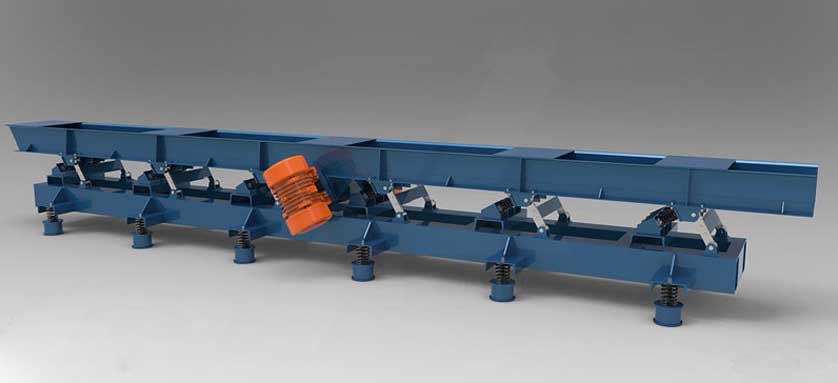Material handling is a crucial aspect of various industries, and selecting the right conveying method is essential for efficient and effective operations. Two commonly used methods for bulk material transportation are vibration conveying and pneumatic conveying. In this article, we will explore the principles, advantages, and applications of both vibration conveying and pneumatic conveying, highlighting their differences and benefits.

Vibration Conveying
Vibration conveying is a technique that utilizes the principles of vibration to transport bulk materials. It involves the use of vibrating conveyors that generate an oscillating motion, causing particles to move along the conveyor. Vibration conveying is widely used in industries such as food processing, pharmaceuticals, and chemicals due to its gentle handling and efficiency.
Working Principle of Vibration Conveying
Vibrating conveyors consist of a trough or tube mounted on springs that vibrate with an oscillating motion. The vibration motion facilitates the movement of particles along the conveyor towards a discharge point. The amplitude, frequency, and direction of the vibration can be adjusted to suit the specific material being conveyed.
Advantages of Vibration Conveying
- Gentle Handling: Vibration conveying exerts minimal force on the transported material, making it ideal for fragile and delicate products.
- Low Energy Consumption: Vibration conveyors require relatively low energy compared to other conveying methods, resulting in cost savings.
- Customizable Design: Vibratory conveyors can be designed to fit specific production needs, including size, shape, and integration into existing systems.
- Versatile Applications: Vibration conveying is suitable for a wide range of materials, from fine powders to large granular solids.
Bulk Material Handling
Bulk material handling refers to the transportation, storage, and control of materials in large quantities. It encompasses various processes, including conveying, loading, unloading, and storage. Efficient bulk material handling is essential for optimizing production processes and ensuring smooth operations.
Challenges in Bulk Material Handling
Bulk material handling poses several challenges, including:
- Segregation: Bulk materials can segregate during handling, resulting in uneven distribution of particles based on size, shape, or density.
- Flowability: Some materials may have poor flow characteristics, leading to issues such as clogging or bridging in conveying systems.
- Contamination: Contamination from foreign particles or environmental factors can affect the quality of the handled materials.
- Safety: Bulk material handling processes should prioritize worker safety and comply with relevant safety standards.
Importance of Efficient Bulk Material Handling
Efficient bulk material handling offers several benefits, including:
- Increased Productivity: Proper material handling ensures smooth operations and minimizes downtime, resulting in increased productivity.
- Cost Savings: Optimized material handling processes reduce energy consumption, minimize waste, and lower maintenance costs.
- Improved Product Quality: Effective handling techniques prevent material degradation, contamination, or segregation, ensuring consistent product quality.
- Enhanced Worker Safety: Well-designed material handling systems prioritize worker safety by minimizing manual handling and providing ergonomic solutions.
Comparison and Selection Considerations: 4 Differences
- Material Characteristics: Both vibration conveying and pneumatic conveying have specific material requirements. Factors such as particle size, shape, density, and moisture content must be considered when selecting the appropriate conveying method.
- Energy Consumption: Vibration conveying generally requires less energy compared to pneumatic conveying. However, the energy consumption depends on various factors, including material properties, conveying distance, and system design.
- Throughput Capacity: Pneumatic conveying systems are known for their high throughput capacity, making them suitable for large-scale operations with high material flow rates. Vibration conveying is better suited for moderate to low-capacity applications.
- Maintenance and Operation: Maintenance requirements and operational considerations should be evaluated when choosing between vibration conveying and pneumatic conveying. Factors such as cleaning procedures, system complexity, and equipment durability are essential considerations.
Final Words
Vibration conveying and pneumatic conveying are two distinct methods for efficient bulk material handling. Vibration conveying excels in gentle handling, low energy consumption, customizable design, and versatile applications. On the other hand, pneumatic conveying offers high throughput capacity, dust-free operation, flexibility in routing, and material preservation. The selection between the two methods depends on various factors, including material characteristics, energy requirements, throughput capacity, and maintenance considerations. By understanding the principles and advantages of both methods, industries can make informed decisions to optimize their bulk material handling processes and achieve efficient operations.
References
- Biermann, C., & Becker, J. (2017). Vibratory conveyors: Design, operation, and selection. Bulk Solids Handling, 37(2), 13-17.
- Skocir, T. S., & Vidmar, J. (2018). Pneumatic conveying in industrial material handling: A review. Engineering Review, 38(1), 52-66.
- Fayed, M. E., & Skocir, T. S. (2017). Handbook of Pneumatic Conveying Engineering. Springer.
- Klinzing, G. E., Rizk, F., & Marcus, R. (2013). Pneumatic Conveying of Solids: A theoretical and practical approach (3rd ed.). Springer Science & Business Media.
- Goodwin, A. (2008). Understanding Solids Flow in Hoppers. Chemical Engineering Progress, 104(3), 26-33.
- Roberts, A. W., & Wypych, P. W. (2018). Vibration Conveying of Material. In Bulk Material Handling by Conveyor Belt 7 (pp. 135-151). Society for Mining, Metallurgy & Exploration.
- Liu, J., & Zhang, Y. (2019). Segregation and Mixing of Particles in Pneumatic Conveying. Chemical Engineering Science, 202, 159-175.
- Hilpipre, A. (2018). The Benefits of Vibration Conveying. Chemical Engineering, 125(2), 32-35.
- Wang, S., & Wang, Y. (2020). Numerical Investigation of Particle Segregation in a Vibrating Conveyor. Powder Technology, 373, 292-301.
- Zanker, A., Tuleja, P., & Wypych, P. (2019). Experimental Evaluation of the Segregation of Fine Particles on a Vibratory Conveyor. Powder Technology, 342, 107-117.